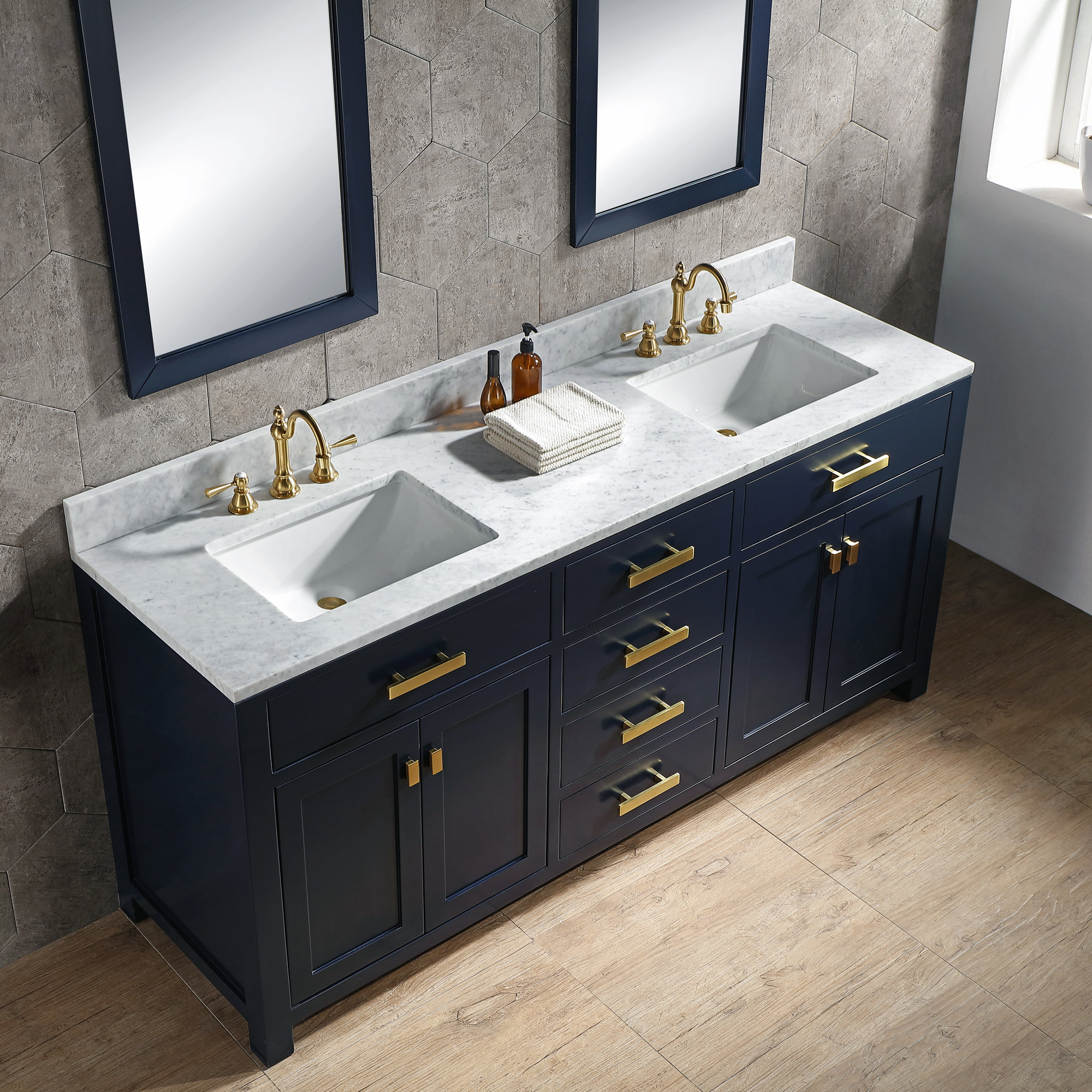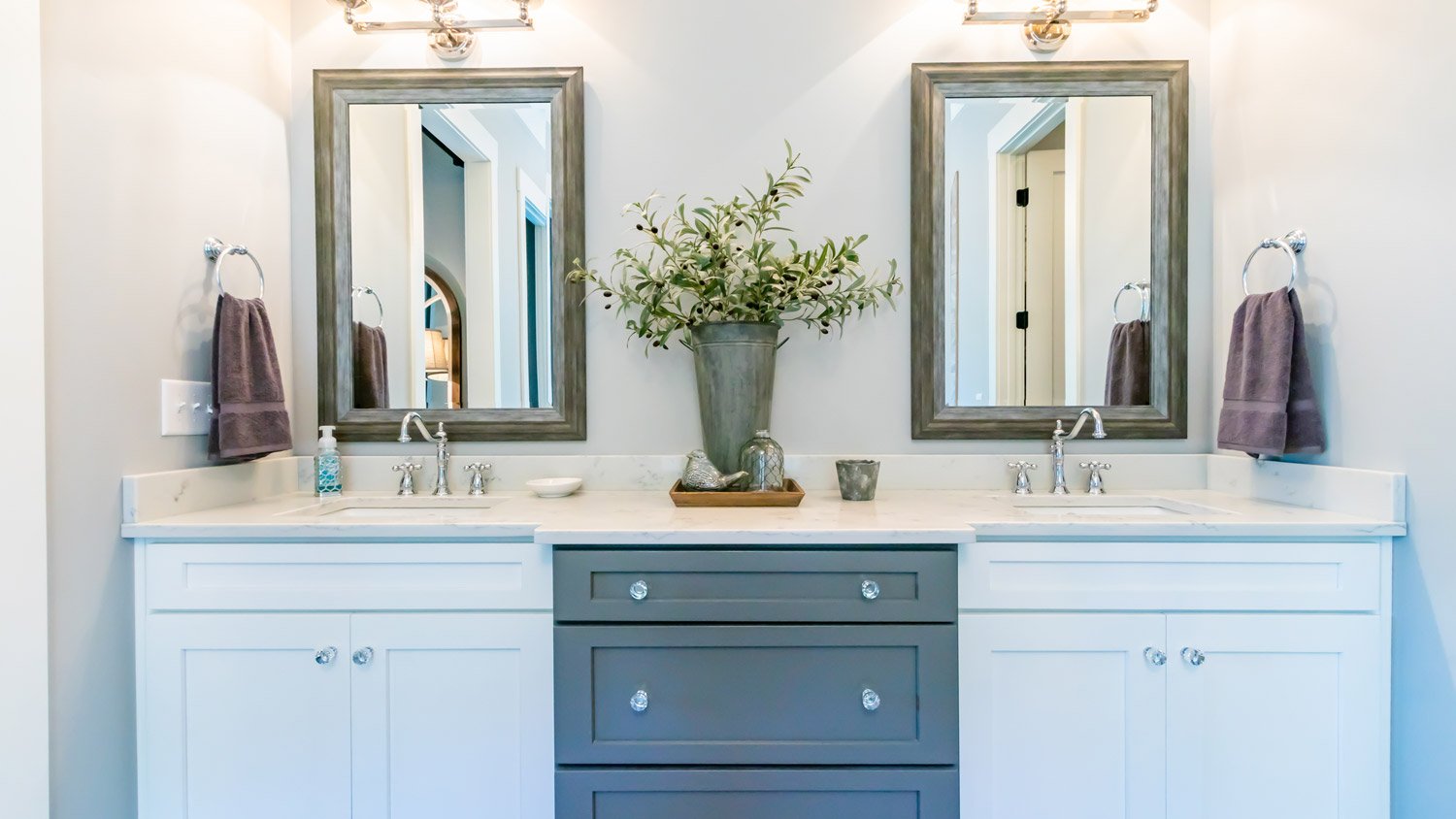Bathroom Cabinet Design Considerations

Installing a bathroom cabinet between sinks presents unique challenges, often requiring careful planning and design to maximize space and functionality. The limited space between sinks, coupled with plumbing fixtures and electrical outlets, necessitates thoughtful consideration of cabinet dimensions, materials, and features.
Design Options
The design of a bathroom cabinet between sinks offers a range of possibilities, catering to various needs and aesthetics.
- Single-door cabinets provide a compact and streamlined solution, ideal for smaller bathrooms or when space is at a premium. They offer a single, large storage area, perfect for storing toiletries, towels, and other bathroom essentials.
- Double-door cabinets offer greater storage capacity and easier access to items within. They are particularly suitable for larger bathrooms or when storing bulkier items.
- Open shelves provide a minimalist and airy feel, offering easy visibility and access to items. They are a good choice for displaying decorative items or frequently used items.
- Combination styles integrate open shelves with enclosed cabinets, combining the benefits of both. This allows for displaying some items while keeping others hidden.
Material Considerations
The choice of material for a bathroom cabinet between sinks is crucial, considering factors such as durability, moisture resistance, and aesthetic appeal.
- Wood is a classic and elegant material, offering a warm and natural feel. However, wood requires regular maintenance to prevent water damage and warping.
- Metal, such as stainless steel or aluminum, is highly durable and resistant to moisture. It is a good choice for modern bathrooms and offers a sleek and contemporary look.
- Plastic is a budget-friendly option, lightweight and easy to clean. It is often used for cabinets with a more contemporary design, but it may not be as durable as wood or metal.
Size and Configuration
Determining the appropriate size and configuration for a bathroom cabinet between sinks is essential for optimal functionality and space utilization.
- Measure the available space between the sinks, including the height and depth. Consider the placement of plumbing fixtures and electrical outlets to ensure adequate clearance.
- Consider the width of the cabinet, ensuring it fits comfortably between the sinks without obstructing access or creating a cramped feel.
- Choose the configuration based on the available space and storage needs. For example, a single-door cabinet might be sufficient for a smaller bathroom, while a double-door cabinet with shelves might be necessary for a larger bathroom.
Features and Functionality
To enhance the functionality and aesthetic appeal of a bathroom cabinet between sinks, consider incorporating features such as:
- Built-in lighting can improve visibility within the cabinet and create a more inviting ambiance. LED lights are energy-efficient and long-lasting, making them a good choice.
- Mirrors can visually expand the space and create a sense of openness. A mirror integrated into the cabinet door or back panel can provide a practical and decorative element.
- Storage compartments, such as drawers, shelves, and baskets, can help organize items efficiently and maximize storage capacity. Consider the types of items you will be storing to determine the most appropriate compartments.
Functionality and Storage Solutions: Bathroom Cabinet Between Sinks

The bathroom cabinet between sinks serves as a vital storage hub, demanding efficient design for optimal functionality. Its success hinges on storage capacity, accessibility, and durability.
Storage Capacity and Accessibility
The cabinet’s storage capacity should accommodate a range of bathroom items, from toiletries to towels, while ensuring easy access.
- Adjustable Shelves: Offer flexibility to customize storage space based on item size and quantity. They can be adjusted to accommodate tall bottles, small jars, and folded towels.
- Pull-out Drawers: Provide easy access to items stored in the back of the cabinet. These drawers can be designed for specific items, like makeup brushes, hair styling tools, or medications.
- Open Shelving: Creates visual appeal and quick access to frequently used items. However, they may require more frequent cleaning to maintain a tidy appearance.
Innovative Storage Solutions
- Rotating Carousels: Maximize storage space in corners and provide easy access to items by rotating the carousel. This solution is ideal for storing frequently used items like toiletries or medications.
- Vertical Storage: Utilize the vertical space effectively with narrow, tall shelves or drawers for storing items like hair dryers, curling irons, or towels. This optimizes space and keeps items organized.
- Over-the-Door Organizers: Offer additional storage for smaller items like hair accessories, brushes, or toiletries. They are ideal for maximizing vertical space and keeping frequently used items within reach.
Advantages and Disadvantages of Storage Options
- Adjustable Shelves:
- Advantages: Highly customizable, flexible for various item sizes, easy to clean.
- Disadvantages: May not be as sturdy as fixed shelves, can be difficult to adjust if heavy items are stored.
- Pull-out Drawers:
- Advantages: Easy access to items, ideal for storing smaller items, can be designed for specific purposes.
- Disadvantages: Can be expensive to implement, may not be suitable for bulky items, requires more space for drawer movement.
- Open Shelving:
- Advantages: Quick access to items, visually appealing, cost-effective.
- Disadvantages: Can be prone to clutter, may not be suitable for storing delicate items, requires frequent cleaning.
Common Bathroom Items for Storage
- Frequently Used Items: Toothbrushes, toothpaste, mouthwash, hand soap, face wash, lotion, hairbrush, comb, makeup remover, cotton swabs, cotton balls.
- Less Frequently Used Items: Hair styling tools (hair dryer, curling iron, straightener), shaving cream, razors, body wash, shampoo, conditioner, medications, first-aid supplies.
- Large Items: Towels, bathrobes, toilet paper, tissue boxes.
Maximizing Storage Space
- Use Vertical Space: Utilize the full height of the cabinet with tall shelves or drawers.
- Group Similar Items: Store items together based on their size and usage frequency. For example, group toiletries, hair care products, and medications separately.
- Utilize Storage Solutions: Employ baskets, trays, and organizers to create compartments within the cabinet, keeping items neatly arranged and easy to access.
- Minimize Clutter: Regularly declutter the cabinet by discarding expired or unused items. This ensures efficient use of space and prevents unnecessary accumulation.
- Label Everything: Label shelves and drawers clearly to easily identify the contents. This makes it easier to find what you need and maintain organization.
Installation and Maintenance

Installing a bathroom cabinet between sinks requires careful planning and execution to ensure proper functionality and longevity. This section will guide you through the installation process, highlighting essential steps, tools, materials, and safety precautions. We will also explore routine maintenance procedures to keep your cabinet in optimal condition.
Installation Process, Bathroom cabinet between sinks
The installation process involves several steps, from preparing the area to securing the cabinet and connecting it to plumbing and electrical fixtures.
- Preparation: Before starting the installation, ensure you have all the necessary tools and materials. These include a stud finder, level, tape measure, drill, screwdriver, saw, safety glasses, gloves, and appropriate fasteners. Additionally, consider the weight of the cabinet and the wall material to select the right anchors or mounting hardware.
- Wall Preparation: Locate the studs in the wall using a stud finder. Mark the stud locations with a pencil or tape. If the cabinet is heavy or if you are installing it on drywall, use wall anchors for added support. Drill pilot holes at the marked locations and install the anchors.
- Cabinet Placement: Carefully position the cabinet between the sinks, ensuring it is level and centered. Use a level to adjust the cabinet’s position until it is perfectly aligned.
- Securing the Cabinet: Secure the cabinet to the wall using the appropriate fasteners. Use screws or bolts to attach the cabinet to the studs or anchors. Make sure the fasteners are long enough to penetrate the wall securely and provide adequate support.
- Plumbing and Electrical Connections: If the cabinet has a sink or other plumbing fixtures, connect them to the existing plumbing lines. Ensure the connections are tight and secure. If the cabinet includes electrical fixtures, connect them to the electrical wiring according to local building codes and safety regulations.
- Finishing Touches: Once the cabinet is installed and connected, install any decorative elements, such as door handles or knobs.
Ventilation and Moisture Control
Proper ventilation and moisture control are crucial for preventing damage and mildew within the cabinet.
- Ventilation: Ensure the cabinet has adequate ventilation to allow air circulation and prevent moisture buildup. Consider installing a small fan or vent to exhaust moisture from the cabinet.
- Moisture Control: Use a sealant or waterproof paint to protect the cabinet’s interior from moisture. Regularly wipe down the cabinet’s surfaces to remove any spills or condensation.
Maintenance Procedures
Regular maintenance is essential to keep your bathroom cabinet between sinks in good condition.
- Cleaning: Clean the cabinet regularly with a mild detergent and water. Avoid using harsh chemicals or abrasive cleaners that can damage the cabinet’s finish.
- Sealing: Apply a sealant to the cabinet’s exterior to protect it from moisture and prevent damage.
- Replacing Worn-Out Parts: Replace any worn-out or damaged parts, such as hinges, handles, or shelves, as needed.
Potential Issues and Solutions
During installation or use, you may encounter some common issues. Here are some potential problems and their solutions:
- Uneven Wall: If the wall is uneven, the cabinet may not sit level. Use shims to level the cabinet and ensure it is properly supported.
- Leaking Pipes: If the cabinet has a sink or other plumbing fixtures, check for leaking pipes. Tighten any loose connections or replace damaged pipes as needed.
- Moisture Buildup: If moisture accumulates within the cabinet, ensure adequate ventilation is provided. Consider installing a fan or vent to exhaust moisture.
- Damaged Finish: If the cabinet’s finish is damaged, apply a sealant or waterproof paint to protect it from moisture and prevent further damage.
Bathroom cabinet between sinks – Yo, that space between the sinks in your bathroom? It’s prime real estate for some serious storage. Think about a sleek bathroom cabinet with wicker baskets, like the ones you can find here. They’re totally on point for keeping your bathroom organized and looking fly.
Plus, a cabinet between the sinks is perfect for keeping all your essentials close at hand.
Yo, that space between the sinks in your bathroom? It’s like a mini-storage unit for all your toiletries, right? But sometimes, you need more room for all your stuff, especially if you’re rocking a double sink setup. Check out this 34 bathroom vanity sink cabinet guide, it’s got some dope ideas for organizing your bathroom.
With the right cabinet, you’ll be rollin’ with more space than ever, and your bathroom will be lookin’ fresh af.
